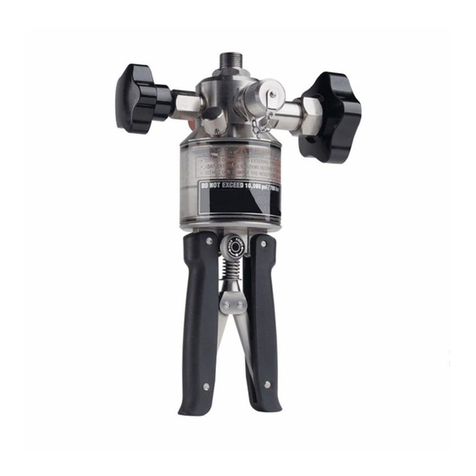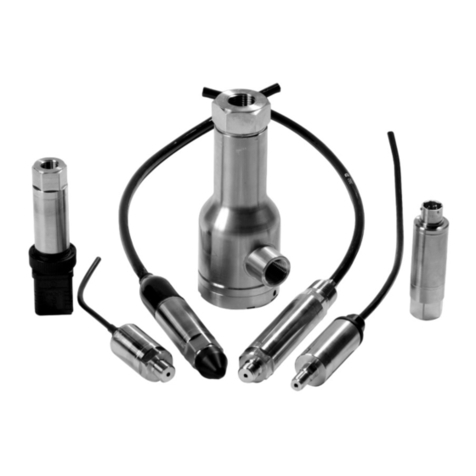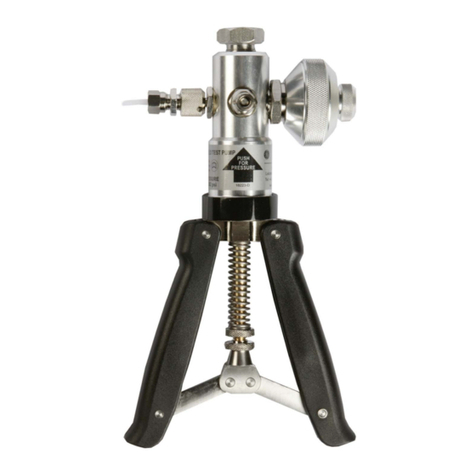
Copyright 2005 Baker Hughes Company.
2 | PV 211 Instruction Manual–English
2.1 Hose/Adaptors (Figure A1)
To attach a hose (5) and adapter (6) to a connector (4),
turn the knurled nut on the connector counterclockwise.
2.2 Pressure Release Valve (Figure A1)
Use this (1) to reduce or release the pressure in the
system. The amount of turn sets the rate to release the
pressure. Only minimum force is necessary to seal the
system.
2.3 Fine Adjust Vernier (Figure A1)
To make accurate adjustments to the pressure, turn the
fine adjust vernier (2) clockwise to increase the pressure or
counterclockwise to decrease the pressure.
2.4 Pressure/Vacuum Selector (Figure A1)
Before you change the mode, make sure that the pressure
release valve (1) is open. To change the mode, use an
applicable tool to push the selector (3) to the side specified
on the label.
2.5 Overpressure Protection (Figure A1)
To adjust the maximum output pressure of the system, turn
the nuts (8) to increase or decrease the stroke length.
3. Operation
3.1 Calibration/Comparison against an
Analog Gauge
1. Connect a reference instrument to the pressure port at
the top of the pump (9).
2. Connect the instrument under test to the connection at
the end of the flexible hose (5).
Note: The maximum torque for the adaptors is 15 Nm
(11 ft lb).
3. Set the fine adjust vernier (2) to the midpoint of its
travel:
Turn it fully clockwise, then four to six turns
counterclockwise.
4. Close the pressure release valve (1):
Turn it fully clockwise, and tighten to seal.
5. Operate the scissor handles (7) until the pressure is
almost correct. To get the maximum pressure output,
squeeze the handles fully together on each stroke.
6. To adjust the pressure to the correct value, turn the fine
adjust vernier (2) clockwise to increase the pressure or
counterclockwise to decrease the pressure.
Note: Initially, small pressure changes can occur
(thermodynamic effects, the seals settle, the hoses
expand). The pressure will stabilize after a short time.
7. You can also decrease the pressure by careful
operation of the pressure release valve (1).
8. To get a vacuum, set the pressure/vacuum selector (3)
to the vacuum position (as indicated on the pump label)
then use the same procedure as above.
Note: Before you change the mode, release the
pressure.
3.2 Operation with a High-Resolution
Pressure Calibrator
Because the resolution is better, it is possible you will see
more of the small pressure changes identified in step 6
above.
Note: On very high resolutions such as 1 mbar or
0.1 inH2O, small movement of the hose may result in
noticeable pressure changes.
4. Fault Finding
1. If the system appears to lose pressure, repeat the
above procedure. Make sure: there is no damage to the
seals, the adapters are tightened sufficiently, the
pressure release valve (1) is tightened sufficiently to
seal.
2. Do not try to tighten the connections between the pump
and the fine adjust vernier (2) or between the pump and
the quick-fit connectors (4). These are factory set and
changes can cause damage to the sealed joints.
3. During leak tests, small air movements (in or out) are
possible around the pressure/vacuum selector (3).
This is normal.
4. If the PV 211 has not been used for a period of time, it
can be difficult to operate on the first stroke. It will
become free after this.
5. For seal replacement refer to the service kit
instructions.
If, for any reason, a fault occurs within the pump, it is
recommended that the equipment be returned to an
appointed agent.
INFORMATION To prevent damage, DO
NOT use force to turn the fine adjust
vernier (2) farther than the red line indicator
on the thread. See item 11 in Figure A2.
WARNING Uncontrolled release of high
pressure is dangerous and may cause
damage to equipment. Because the internal
pressure can get very high during operation,
make sure that all the connections are made
correctly.
DO NOT ignore the maximum operating
pressure specified on the pump label.
Before you connect a pressure component to
the PV 211, make sure that it is isolated from
the pressure supply and release the internal
pressure slowly. DO NOT connect the pump to
an external pressure source.
INFORMATION To prevent damage, DO
NOT use force to turn the fine adjust
vernier (2) farther than the red line indicator
on the thread. See item 11 in Figure A2.






























